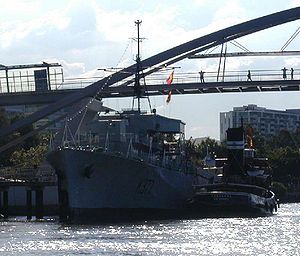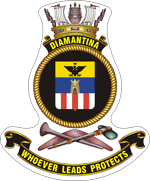HMAS Diamantina (K377)
| 50x40px | This article includes a list of references, related reading or external links, but its sources remain unclear because it lacks inline citations. Please improve this article by introducing more precise citations where appropriate. (April 2009) |
 HMAS Diamantina (K377) | |
| Career (Australia (RAN)) | |
|---|---|
| Namesake: | Diamantina River |
| Builder: | Walkers Ltd., Maryborough |
| Laid down: | 12 April 1943 |
| Launched: | 6 April 1944 |
| Commissioned: | 27 April 1945 |
| Recommissioned: | 22 June 1959 |
| Decommissioned: | 21 February 1980 |
| Motto: | "Whoever Leads Protects" |
| Honours and awards: |
Battle honours: Pacific 1945[1] |
| Status: | Preserved as a museum ship at Queensland Maritime Museum |
| Badge: |
 |
| General characteristics | |
| Class and type: | River class frigate |
| Displacement: |
1,420 long tons (Template:Convert/t ST) 2,020 long tons (Template:Convert/t ST) (deep load) |
| Length: |
283 feet (86.26 m) p/p 301.25 feet (91.82 m)o/a |
| Beam: | 36.5 feet (11.13 m) |
| Draught: | 9 feet (2.74 m); 13 feet (3.96 m) (deep load) |
| Propulsion: | 2 x Admiralty 3-drum boilers, 2 shafts, reciprocating vertical triple expansion, 5,500 ihp (4,100 kW) |
| Speed: | 20 knots (37.0 km/h) |
| Range: | 500 long tons (Template:Convert/t ST) oil fuel; 5,180 nautical miles (9,593 km) at 12 knots (22.2 km/h) |
| Complement: | 140 |
| Armament: |
|
HMAS Diamantina (K377/F377/A266/GOR266), named for the Diamantina River in Queensland, is a River class frigate that served the Royal Australian Navy (RAN). Constructed in the mid-1940s, Diamantina was active from 1945 until 1946, was placed in reserve, then was recommissioned as a survey ship from 1959 until 1980.
Following her second decommissioning, the frigate was preserved at the Queensland Maritime Museum as a museum ship. She was the last World War II-era frigate to leave RAN service, and of the 151 River class frigates constructed, which saw service in 19 navies worldwide from 1942 onwards, Diamantina is the only one preserved as a museum ship.
Contents
Design and construction
Diamantina had a displacement of 2,120 tons fully loaded, or 1,420 standard displacement tons. She was equipped with two triple expansion engines driving twin screws at 5500 l.h.p. She had a range of 5,180 nautical miles (9,593 km) at 12 knots (22.2 km/h), with a top speed of 20 knots (37.0 km/h).
Diamantina was laid down on 12 April 1943 at Walkers Limited in Maryborough, Queensland. She was launched on 6 April 1944, and commissioned into the RAN at Hervey Bay, Queensland on 27 April 1945 carrying pennant number K377. She was named for the Diamantina River in Queensland, and was one of eight River Class frigates built for the RAN during World War II.
Operational history
1945-1946
Diamantina provided fire support to the Australian Army operating in Bougainville in July and August 1945.
The frigate carried Lieutenant General Kanda and Vice Admiral Baron Samejima, officers of the Japanese Imperial High Command to the surrender of Torokina on 8 September 1945. She was also involved in the surrenders of Nauru on 13 September and Ocean Island on 1 October; both ceremonies conducted on her quarterdeck.
Diamantina returned to Sydney, arriving at Garden Island on 13 December 1945 with 86 passengers embarked. The ship remained in Sydney until 1 February 1946, when she departed for a patrol in New Guinea waters. Diamantina returned to Sydney on 14 June, and was paid off into reserve on 9 August 1946.
1959-1980
Diamantina was recommissioned as an oceanographic survey ship on 22 June 1959. She carried the pennant numbers F377, A266, and GOR266 at various points throughout this period of her career. After successfully completing her first oceanographic survey in July, she embarked on her first oceanographic cruise on 20 August. On 20 September, the ship performed the first survey of the Montebello Islands following the British atomic test, Operation Hurricane. On 22 October, Diamantina carried out the first survey of the waters around Christmas Island.
Diamantina’s most notable achievement during her second commission was the discovery of the deepest known part of the Indian Ocean on 7 February 1960, which was named Diamantina Deep after the ship.
Based in Fremantle, Western Australia, Diamantina remained in service as an oceanographic vessel until 1980.
Decommissioning and preservation
Diamantina paid off from the RAN on 29 February 1980, and was the last World War II-era frigate to serve Australia. Diamantina was handed over to the Queensland Maritime Museum where she is permanently berthed in the drydock located on the Brisbane River at South Brisbane.
In March 2006, Diamantina was towed out into the river to allow repairs to the dock, which had been flooded since the seals failed in 1998. As of July 2006, she has been returned to the dry dock adjacent to the Queensland Maritime Museum, where she is used as a self-touring museum ship.
References
- ↑ Festberg, Alfred N. (1981). Heraldry in the Royal Australian Navy. Melbourne, VIC: Silverleaf Publishing. p. 40. ISBN 0949746002. OCLC 9780949746009.
| HMAS Diamantina (K377)
]]Coordinates: 27°28′55″S 153°1′36″E / 27.48194°S 153.02667°E
- Pages with broken file links
- Articles lacking in-text citations from April 2009
- Articles with invalid date parameter in template
- All articles lacking in-text citations
- River class frigates of the Royal Australian Navy
- Frigates of the Royal Australian Navy
- Royal Australian Navy survey ships
- Museum ships in Australia
- Visitor attractions in Brisbane
- 1944 ships

